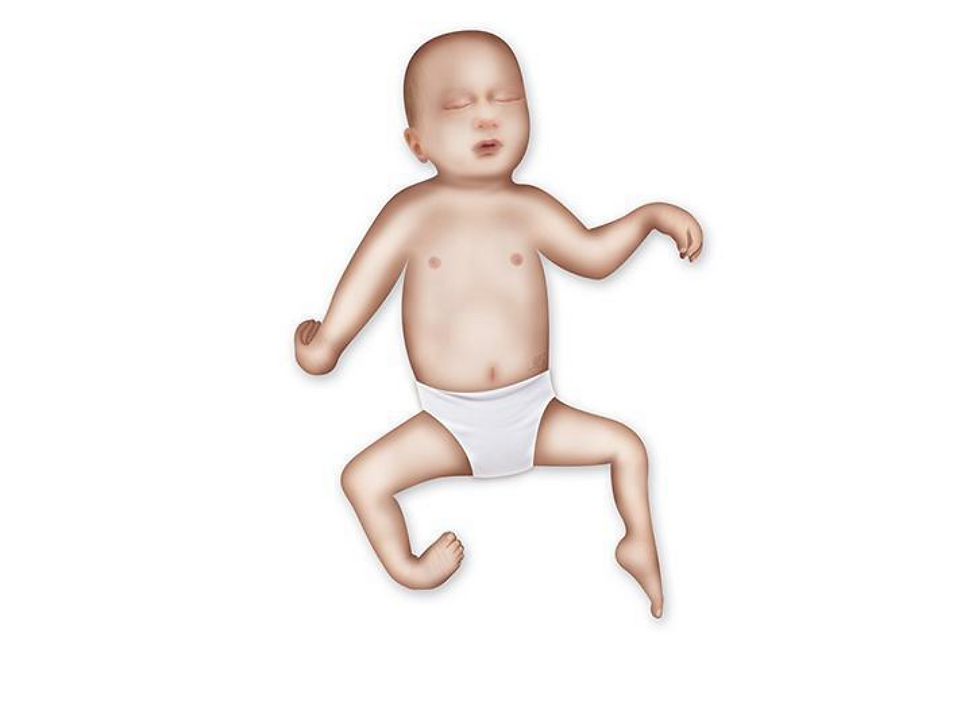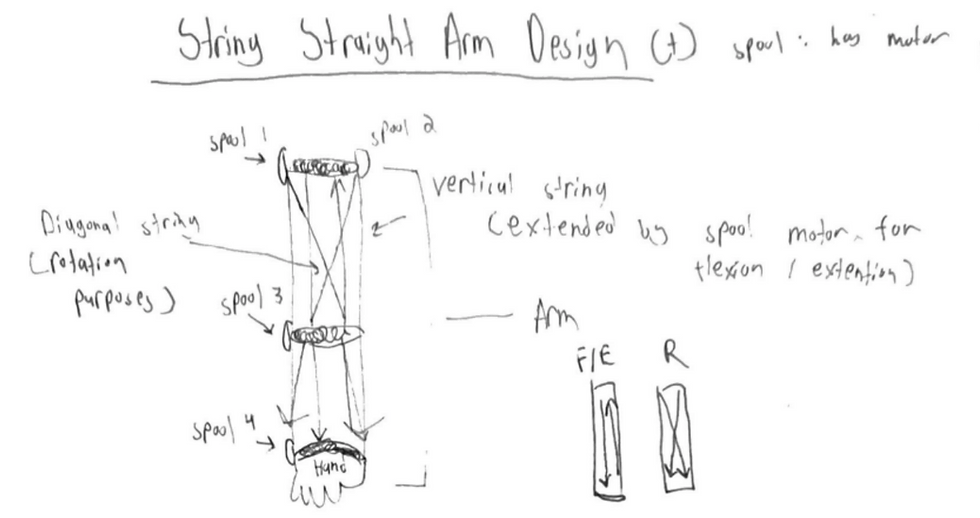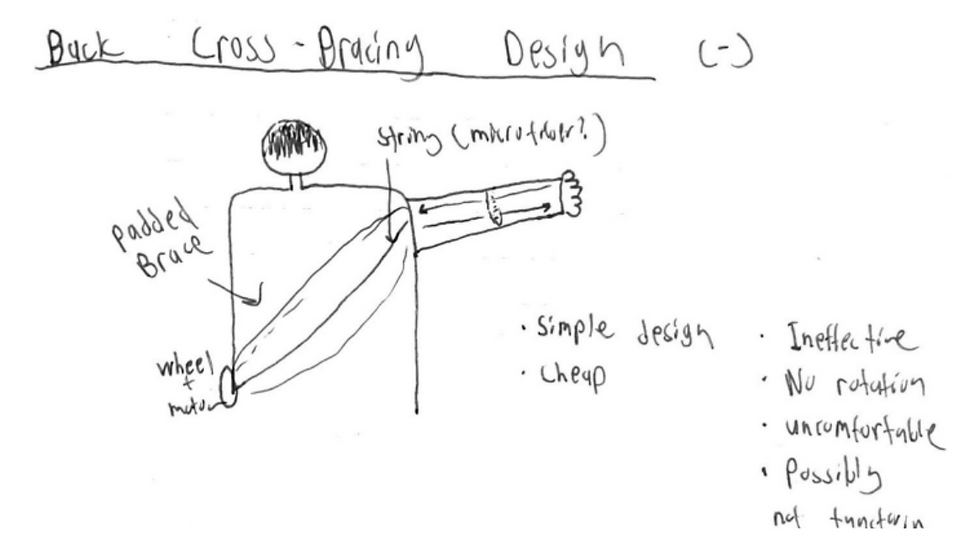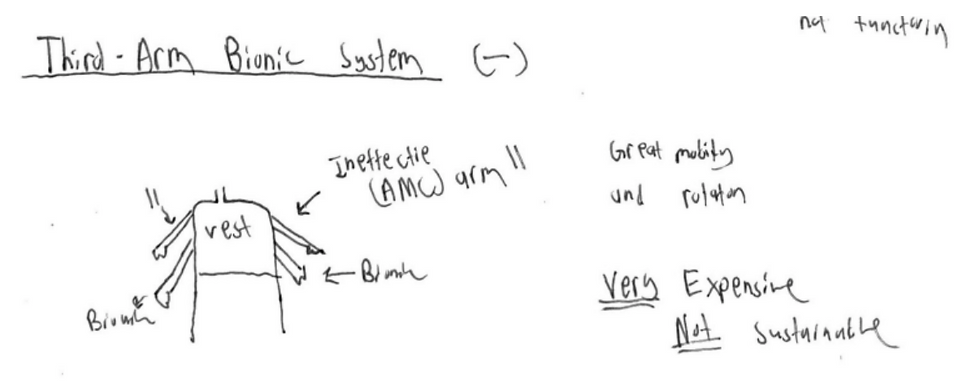HEAR PHASE
Introduction
Arthrogryposis, also known as arthrogryposis multiplex congenita (AMC), is a chronic condition seen involving joint stiffness and abnormal muscle meekness from birth. Arthrogryposis involves multiple contractures, which are joint deformities, and causes a joint to be fixed in place (1, 2). Arthrogryposis is due to birth defects and caused by genetic mutations in the muscle cells (8). Around the world, arthrogryposis affects around one in 3,000 people (2, 4). Individuals suffering with arthrogryposis have typical lifespans, as it is non-progressive (2). There is currently no cure for arthrogryposis, but treatment and aid are available (2). Surgery is a potential solution for arthrogryposis; however, it is expensive and may be unavailable in low-income areas (3).

Figure 1: Infant with arthrogryposis
The United Nations’ Sustainable Development Goals (SDGs) that apply to our solution for arthrogryposis are (7):
#3 Good Health and Well-Being
To make individuals with arthrogryposis feel at ease, we are promoting individuals’ health and well-being.
#8 Decent Work and Economic Growth
With the help of our device, individuals with arthritis will be able to participate normally in daily activities, including participating in the workforce. Manufacturers’ jobs will also be boosted because of our product.
#9 Industry, Innovation, and Infrastructure
The process of creating our solution for Arthrogryposis involves innovation. We create the infrastructure of our product with the help of manufacturing in the engineering industry.
#10 Reduced Inequalities
One of our top priorities is for patients with arthrogryposis from all income levels to access.
#17 Partnerships for the Goals
We must collaborate on small and large scales to create our product.
Problem Statement and Description
Individuals with arthrogryposis face several challenges which can cause problems for their daily life and their overall wellbeing. These problems can be physical, emotional, social, and practical in nature, and addressing them requires a comprehensive approach. The physical challenges posed by arthrogryposis are at the forefront of the daily lives of patients. The condition’s hallmark joint contractures and muscle weakness severely restrict mobility and fine motor control. Simple tasks that most people take for granted such as getting dressed or reaching for objects become arduous endeavors. The limitations in movement and strength necessitate the use of mobility aids such as wheelchair or orthotic devices to enhance independence. However, even with these aids navigating inaccessible environments and uneven terrain can be a constant struggle. Orthopedic complications are common among people with arthrogryposis and can further exacerbate physical challenges. Joint deformities, scoliosis, hip dislocations, and foot abnormalities are frequently observed (3). These complications not only cause pain and discomfort but also impose physical limitations on individuals, impacting their ability to perform everyday tasks. Orthopedic complications are also faced daily. This can cause pain, discomfort, and physical imitations which may require surgical interventions or ongoing medical management. Maintaining proper posture and alignment is crucial to prevent further complications and maximize functional abilities. Poor posture can lead to discomfort, back pain, and an increased risk of orthopedic problems. Proper seating and positioning aids, along with regular physiotherapy are essential in managing these challenges (3). Furthermore, individuals with arthrogryposis often experience challenges related to self-care and personal hygiene. Limited hand or finger mobility can make daily tasks such as grooming, brushing your teeth or even using the restroom difficult (6). In addition to physical challenges, emotional and social factors can significantly impact individuals with arthrogryposis. Living with a physical disability can lead to social stigma, discrimination, and feelings of isolation. Negative attitudes and lack of awareness in society can limit opportunities for inclusion and participation in various activities. Practical issues related to accessibility and transportation further compound the challenges faced by these individuals. Inaccessible infrastructure, public spaces and transportation systems can limit independent mobility and restrict participation in community activities. The lack of accessible vehicles and public transportation options can create significant barriers to employment, education, health care, and social engagement.
Needs Statement
An inexpensive way to enhance the functionality of individuals suffering from arthrogryposis so they may comfortably extend and rotate their arms to carry out daily tasks.
Market Size
One in 3000 children are born with arthrogryposis (2, 4). It is very common for patients to have their limbs affected, and thus it is expected that 3 in 4 people with arthrogryposis will benefit from this device. Moreover, patients who have similar symptoms comparable to arthrogryposis or those who have difficulty carrying out tasks regarded by the device would also be benefitted.
Prior Art
In the first two years of birth, arthrogryposis could be treated by stretching and physiotherapy, which can offer a significant range of motion and flexibility improvements. Surgery to skin, tissue, tendons, and muscles, has positive effects, however stretching exercises and further therapy is needed for the effects of surgeries to remain (5). A major flaw to these methods is the need for physiotherapy services to be available and done to the patient at a young age. These services are costly and take a lot of time for the patient and their families. Without access to these services, no formal treatment would be received, and the deformities will be carried onto later stages of life, where treatment will have a lesser effect.
Many current orthopedic solutions such as wheelchairs, crutches, and stagnant braces are more so workarounds than solutions that address the problem at hand (4). It is important to devise a more accessible and more versatile approach that can support the patients in carrying out tasks independently and live like a normal person.
Questions
What types of treatment/solutions exist for those suffering with arthrogryposis?
How common is the inability to comfortably utilize specifically arms for those with arthrogryposis?
Could a solution for arthrogryposis immobility be translated to other illnesses and conditions involving moderate to severe arm paralysis?
How effective is PT for those with ACD on a general basis?
How many cheap and sustainable solutions currently exist for those suffering from arthrogryposis?
What impact can a motorized/bionic solution have on infants/children vs adults in the long-term?
How can one develop a “one size fits all” approach especially when all limbs are unique and different for those with arthrogryposis?
Can you describe the specific challenges you face in your daily life due to arthrogryposis-related limitations in arm mobility?
Have you come across any existing products or assistive devices that have helped you in improving your arm mobility? If yes, could you describe them and how they have made a difference?
Design Requirements
Must Haves:
Relatively inexpensive
Adaptable for different sizes, ages, and condition severity
Can be controlled by feet or hands.
(Condition dependent)
Ability for rotation
Ability for flexion and extension
Safe and comfortable
Access to batteries/electricity
Nice to Haves:
Aesthetically pleasing
User friendly
Lightweight
Waterproof
Easy to clean.
Can be worn easily.
Can last for a relatively longer time.
CREATE PHASE
Brainstorming Method
After individually creating our own ideas, we formed a multitude and began narrowing down from there. This is known as the round robin method. This method helped us all build upon each other's ideas and led us to ultimately come to our final solution, though it needed some modifications.
Potential Solutions and Additional Brainstorming Diagrams

Figure 2: Straight Arm String Design (very much potential)

Figure 3: Back Cross Bracing Design (quite unlikely)

Figure 4: Third New Arm Bionic System (very unlikely and costly)

Figure 5: Early-Stage Brainstorming of Elbow Bend Method (very much potential)
Others (much less potential):
Brace self-correcting system:
Entails a brace fit perfectly around a uniquely conformed arthrogryposis arm and slowly works to adjust and loosen up the arm.
Long-term process, very little to no short-term of a solution
Extremely costly and not suitable for lower middle-income consumers
Electroshock arm correction:
Dangerous and possibly painful
Unproven theories
Overall, not nearly a suitable idea
Spring mechanism rotation and flexion:
No cheap/lightweight spring exists that can fully account for the push/pull force of an entire arm between a 180-degree movement area.
Solution Selection

Figure 2: Design matrix (above)
We chose to assess our brainstormed ideas by the standard design matrix. Ultimately, our ranking system led us towards the Elbow Wheel Design. Our group used a rating scale of 1-5, with 5 being the highest. The group commonly decided on the importance of all requirements and gave each a rating. The most important components of this design were its ability to flex and extend, since that is the goal of our project. The ability to rotate is also a crucial component of the project. The product should also be comfortable and inexpensive as in our need statement. It should also be adaptable to different people of different age groups with different arm sizes which they can adapt to easily.
Justification of final design
The elbow wheel design received the highest score and is ultimately the design of our project. This design incorporates all our needs and incorporates the most important criteria extremely well. The most important feature of the product is the strings. The strings do the job of mimicking the tendons which will help our arm to extend flex and rotate in any of the sides too. For the same reason, three strings are used in our design. There are two strings which will help the arm to rotate. These are placed near the elbows in a crossed way, so that whenever one of the strings is pulled, it causes the arm to rotate in either of the sides. The third string is placed near the bicep muscles. This is used for flexion and extension of the arm.
Design Sketch
Also includes a Safety emergency button to turn off and disengage.
Remote, wheels with spools, motors, bands, straps

DELIVER PHASE
Proof of Concept/Prototype Proposal
To access the functionality of the Elbow Wheel Design, there will be thorough experiments that take place. Firstly, to test the mobility of the device, an individual with normal arm condition will wear the Elbow Wheel Design device and relax their arm, allowing the device to perform various arm movements such as bending, extending, flexing, and rotating. We will access the device’s ability to do these tasks without the help of the test subject’s inherent arm mobility movements. In the experiment, we will test the functionality of the four segments of strings: the forearm’s three strings (two diagonal and one vertical) and the upper arm’s string (located on top of the bicep). We will also test the motor and the wheels located at the inner elbow, upper arm, and wrist. Additionally, we will test the emergency button and see how the device will correctly shut down in case of an emergency. Given that this experiment is successful in terms of its ability to be adaptable, rotate, flex, bend, and extend, we will then move on to experiment the Elbow Wheel Design on a patient with arthrogryposis and repeat the movements of the device. Any failures encountered will be located and the device will be modified accordingly.





Forward and backward movement controls the extension and flexion of the arm. Left and right control the rotation of the arm. The connectivity program would be quite simple:
The left function would move the right motor clockwise and the left motor counterclockwise.
The right function would move the left motor clockwise and the right motor counterclockwise.
Timeline of Project
End of July 2023: Prototype is finalized and made, ready for trials.
September 2023: more prototypes are made and are set for trials for different people from different places.
December 2023: patients for trial are found and the product is delivered to them for trial.
February 2024: feedback of the prototype is taken, and changes are started to be made.
April 2024: changes have been made and sent to trial again.
June 2024: (if no problems) partnerships are sought out with companies and people willing to fund our product.
August 2024: Manufacturing begins.
Materials List

Anticipated Partnerships
We plan to collaborate on research of arthrogryposis with the:
National Institute of Health (NIH)
The Arthrogryposis Group in the National Organization for Rare Disorders
We plan to advance our engineering to aid arthrogryposis with:
Biomedical Engineering Society
Duke University
We plan to seek investors and funding for arthrogryposis research and engineering with the:
Healthcare angel investors
World Bank
Conclusion
Arthrogryposis is a global condition. This is faced by more than 24 million people around the world. It causes mental, physical, and social problems for the patient. A way to help these patients is very important. The string spool motor system and arm kinematics helps the users to flex, extend and rotate their arm in a way of their choice. It provides a way for the user to prevent any social embarrassment from their condition and can maybe help them live a life as close to being normal as it can. This is done in an inexpensive way — unlike any surgery or prosthetic arm, our product will be less costly and easy to use. It will be adaptable to different people with arms of different sizes. Our product will make the lives of the users comfortable and easier to live in.8.
Bibliography
Clinical Orthopedics and Related Research (1976-2007): April 1985 Lester R. Problems with the upper limb in arthrogryposis. J Child Ortho. 2015 Dec;9(6):473-6. doi: 10.1007/s11832-015-0694-4. Epub 2015 Oct 19. PMID: 26482520; PMCID: PMC4661158.
Arthrogryposis. (AMC): Overview, Causes, Diagnosis and Treatment. (n.d.). https://www.nationwidechildrens.org/conditions/arthrogryposis#:~:text=This%20is%20a%20rare%20disorder,of%20every%2010%2C000%20live%20births
Arthrogryposis. JHM. (2021a, August 8). https://www.hopkinsmedicine.org/health/conditions-and-diseases/arthrogryposis
Arthrogryposis - Seattle Children’s. Seattle Children’s Hospital. (n.d.). https://www.seattlechildrens.org/conditions/arthrogryposis/
Lester, R. (2015, December). Problems with the upper limb in Arthrogryposis. Journal of children’s orthopaedics. https://www.ncbi.nlm.nih.gov/pmc/articles/PMC4661158/
YouTube. (2019, July 25). AMC Princess Ana & Eating with arthrogryposis. YouTube. https://www.youtube.com/watch?v=X4tpOBGqsqg
United Nations. (n.d.). The 17 goals | sustainable development. United Nations. https://sdgs.un.org/goals
U.S. National Library of Medicine. (n.d.). Distal arthrogryposis type 1: Medlineplus Genetics. MedlinePlus. https://medlineplus.gov/genetics/condition/distal-arthrogryposis-type-1/#causes




Comments